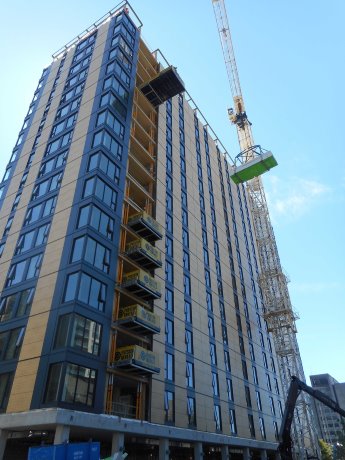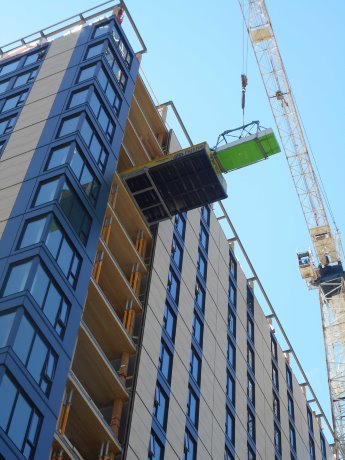As the University of B.C.’s Brock Commons — the largest mass timber structure in the world to date standing 18 storeys and 54 metres — rises on campus, it is casting a construction shadow that extends far north.
"The building is catching the interest of architects and engineers because it is an unusual way to build a tall building and also because it went up quickly," said heavy timber specialist Dave Gardner for Structurlam, the Penticton manufacturer supplying the mass timbers (cross laminated timber known as CLT and glulam beams) used in the Brock Commons residential building.
There is a growing awareness of what that can mean to northern construction, especially in a climate with a compressed construction window.
"CLT can be an excellent choice (in cold climates) and we are getting more inquiries," said Gardner, who has fielded queries from architects across northern B.C. areas, the Yukon and east as far as Manitoba.
Brock Commons and the eight-storey Prince George Wood Innovation Design Centre (WIDC) are attracting attention as they show the attributes of prefab construction, many of which are advantageous in adverse terrain or in northern regions.
Gardner said there still remains a strong "traditional culture of steel and concrete" amongst contractors who stick with what they know, despite the attention these buildings are getting. But, change is happening.
"It is a new way of thinking inside companies. Some companies are early adapters and some come later," he said. A group of business partners in B.C.’s Interior announced in June their intention to build a 20-storey wood building at Penticton’s Lakeside Resort with an interior construction firm, pending city approval.
Urban One Builders has been quick off the mark, realizing CLT’s potential.
"This kind of construction offers a huge benefit to northern areas," said Urban One’s senior project manager Karla Fraser, in charge of Brock Commons and who has also worked in remote areas on projects.
She said that in northern regions, planning and prefabrication work could be done in advance during inclement weather. Once the slab is down, assembly would follow quickly.
Brock Commons, which is a hybrid structure, has concrete cores and lower floors and a steel roof. It went up at the rate of one floor every three days.
It used CLT floor slabs and glu-lam columns all joined with steel connectors. Once finished in 2017, it will target LEED Gold.
"We were doing two floors a week," said Fraser. That included not just the installation of the mass timber components but also the building’s exterior panels, which came with windows installed.
The assembly of the components began June 10 and was completed on levels three to 18 by August 9.
With that kind of speed, it makes mid-rise structures feasible in northern extreme climates where it is too difficult for crews to work outside in the cold.
Fraser said that a factor in expediting the assembling was the use of computer modelling, not just for the building’s structure but Urban One also worked with the associated trades to ensure the structure and the finished prefabricated components delivered to site would work smoothly for the associated trades.
"It is not just quick — it is efficient as it reduces trades and traffic on site," she said.
"There are massive amounts of savings with less equipment, materials on site and workers on site."
There is also less waste material or formwork from concrete to haul from the site.
All these factors combine to provide advantages to working in northern regions where accommodations may have to be sourced while a structure is being built by traditional methods.
While contractors are hesitant to take on a new construction method not fully understood, Urban One was able to bring expertise to the Brock Commons site through Seagate Structures.
Ralph Austin founded parent company Seagate Consulting in response to more prefabrication and large timber construction in the marketplace. He agrees this type of construction is suited for northern areas, but "it really would work anywhere."
"The key is prefabrication," he said. "Bring the pieces to the site and install them like a LEGO set."
An advantage that mass timber construction presents in cold weather climates is the ability to place insulation and reduce the thermal break.
"All the insulation goes on the outside and there is no thermal break — it is like putting a jacket on," said technical adviser Bill Billups for Wood WORKS! B.C.
While the Prince George WIDC was built to show the feasibility of building an eight-storey wood structure, Brock Commons has led on efficiencies.
"Brock is proving to be a business case," he said, as it is demonstrating that while the front-end costs are higher, the ability to fast track a building benefits the owner in terms of financing and occupancy.
Billups said the use of prefab construction is a major shift in how the industry operates today and general contracting companies and small contractors are all going through a learning curve of how to handle this new style of construction ranging from the design phase through to handling and storage of the mass timber panels.
He said that in November, Wood WORKS! B.C. is hoping to host a seminar on Brock Commons that will provide information on the design and assembly of the building.
He is hoping that some of the technical material can be captured in videos or in educational material that could be disseminated through construction associations to members in regions outside Vancouver.
Billups said there is a gap appearing in the construction industry though.
As B.C. moves towards a skills shortage that will lead to more prefabrication, there is the need for carpenters to learn the skills of handling these large CLT or mass timber components and how they are joined.
He is an advocate of including such skill sets in journeymen carpentry training.
In northern areas, Billups said the ability to construct with prefabricated panels could lend itself to government buildings, community facility and multiple unit residential buildings.
Simon Lintz, business development manager for StructureCraft Builders in Delta, said the company has provided some materials to buildings in northern climates such as Edmonton’s renovated federal building and the Philip J. Currie Dinosaur Museum.
Lintz said that oil and pipeline companies have also explored the concept of building camps out of prefabricated mass timber components with one proposal recently placed on hold.
"There are good advantages to using wood — essentially since the window for building in the north is a much shorter season. In the case of wood structures you can do a lot of the building off site and off-season. These building tend to go up fairly quickly," said Lintz, adding that panels can be fabricated to receive utilities.
"You can cut the holes for the plumbing — now you have just saved a lot of time for the plumbing contractor," he said.
Buildings such as Brock and the WIDC are heightening interest, he agrees.
"People are also beginning to understand it and that there is also better quality achieved when components are manufactured."
Lintz said pre-builds such as modules or trailers are common in the northern region, but prefabrication offers transport advantages as more components can be shipped in the same space it take for a modular unit to be sent to a northern site.
"You are not transporting air," he said.

1/2
Brock Commons is providing a business case example for building in B.C.’s northern area where rapid assembly of the building’s structural elements and exterior panels can mean trade crews are inside when the big chills hit. Here you see drywall being lifted into place as trade crews work inside.
Photo: Jean Sorenson











Recent Comments
comments for this post are closed